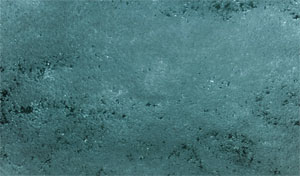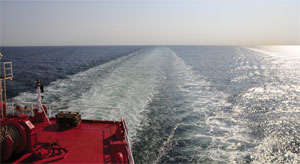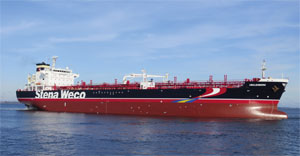In the ongoing quest to reduce fuel usage and carbon dioxide emissions, vessel designers are turning to a cushion of air to reduce hull drag.
Manufacturers say air lubrication systems can cut CO2 emissions by 5 percent to 25 percent, which can be especially critical for vessels operating in Emission Control Areas. The systems are a growing part of the eco-arsenal for reducing emissions, along with liquefied natural gas (LNG), hybrid drive propulsion, diesel scrubbers, waste heat recovery and other technologies that are evolving to meet tightening environmental regulations.
Air lubrication systems are based on the fact that a thin layer of bubbles under a ship’s hull can reduce hydrodynamic drag, which results in less demand on the propulsion system. Electric pumps blow air through fixtures mounted in the hull to create a layer of microscopic bubbles.
So far, 10 vessels have the Mitsubishi air lubrication system (MALS) developed in conjunction with carrier NYK, according to Hirokazu Miyagi, project manager at Mitsubishi Heavy Industries’ (MHI) Shipbuilding & Ocean Development Division.
Agricultural giant Archer Daniels Midland (ADM) has taken delivery of the first of three 778-foot, post-Panamax bulk grain carriers built at Oshima Shipbuilding Co. in Nagasaki that use the Mitsubishi system. Mitsubishi said early tests show the reduced frictional resistance translated to a 27 percent reduction in CO2 emissions compared to conventional bulk carriers.
An Archer Daniels Midland representative declined to provide further details about the vessel’s operation.
Mitsubishi’s system has already been adopted in smaller vessels such as module carriers, ferries and other ships built by MHI. It’s been ordered on two 125,000-gt cruise ships for AIDA Cruises, a German brand of Carnival Corp. The system is expected to reduce fuel consumption by approximately 7 percent in the vessels, which are due for delivery in 2015 and 2016.
The ADM bulker, like most of the other vessels equipped with an air lubrication system, was designed with a flat bottom to provide a bed for the air bubbles, Miyagi said.
 |
|
A close-up of the microbubbles. |
|
Photos courtesy Silverstream |
Damen Shipyard Group in the Netherlands is building the EcoLiner, an inland waterways vessel with a flat bottom, for the first application of its air chamber energy saving (ACES) system.
“The system must be integrated in the construction, and to have full efficiency of the system it is necessary to adjust fore and aft properly to the ACES system,” said Rob Schuurmans, project manager for the EcoLiner. The vessel pairs air lubrication with LNG-fueled generators that power the propulsion and all other onboard systems and a waste-heat recovery system to heat or cool accommodation spaces or cargo holds.
Mitsubishi installed its MALS on a flat-hulled ferry with a slender form, which reduced fuel consumption by 5 percent. Tests with Ferry Naminoue, operated by Japan’s A-Line Ferry Co. Ltd., found the technology worked well on high-speed, slender ships. Naminoue is 476 feet long, with 8,072 gross tons and a design draft of 6.2 meters.
The Silverstream system doesn’t require a flat hull design, according to Noah Silberschmidt, CEO of Silverstream Technologies, but it helps.
“It is applicable for full-bodied or flat-bottomed vessels above 150 meters in length,” Silberschmidt said. “However, the system will also work very well for any vessel that … operates at high speeds and consumes large quantities of fuel oil, where a 5 percent net efficiency gain is very significant.”
The Silverstream system has been chosen for the Norwegian Cruise Line vessel Norwegian Bliss, scheduled for delivery in spring 2017 from the Meyer Werft shipyard in Germany. There is an option for two additional Norwegian Cruise Line vessels to be fitted with the Silverstream system, and the company is in conversations with a number of shipowners and charterers in a range of sectors regarding installation of the system, Silberschmidt said.
It might be possible to retrofit an air lubrication system to an existing vessel, depending on the design.
“It is possible, but you must take into account that the construction must meet certain requirements in order to reach for full efficiency,” Schuurmans said. Damen’s ACES requires a flat bottom, but the Silverstream system could be retrofit.
 |
|
The bubble carpet. |
|
Photos courtesy Silverstream |
“For existing vessels, the Silverstream system can be retrofitted in just 14 days,” Silberschmidt said.
Operation of an air lubrication system is basically invisible. Air is supplied by electric pumps, which are regulated by sensors and software to start and stop the air stream. The systems can be turned on and off manually as well.
Like Damen’s ACES, the Silverstream system automatically regulates the compressors depending on the draft and speed of the vessel.
“The compressors keep the cavities in the hull of the vessel filled with air at the right pressure,” Silberschmidt said. “As the vessel steams, air is released behind each cavity, which in turn forms a thin but rigid layer of microbubbles.”
Schuurmans noted that during full-scale tests propulsion noise was lower, fuel consumption was reduced and the ship was easier to maneuver.
Although the air systems are not designed to increase a vessel’s speed, they could lead to smaller engines being required. Damen’s ACES will be installed first on an inland waterways vessel, which “is not shaped for speed in the first place,” Schuurmans said. “So, at the same speed we need less power for propulsion because of lowering the friction.”
Silberschmidt said operations would reflect vessel owners’ priorities.
“The shipowner can choose whether to save fuel or increase speed and in today’s market, fuel saving is the name of the game,” he said.

